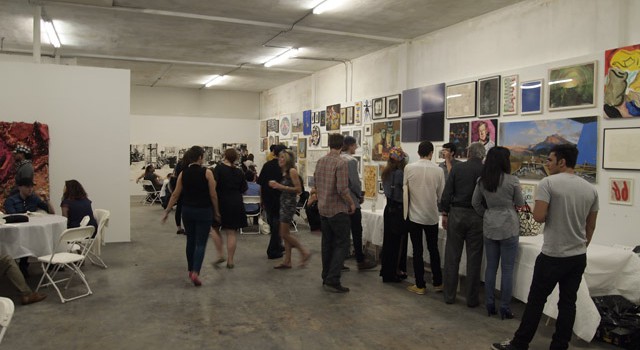
Clockwise from left, Frank Bowling's paintings, a set of William Powhida drawings, Bo Bartlett's "The Big Day", Hew Locke's "HMS Belfast", and four of Tatiana Berg's tents, at SEVEN.
There’s not much point in comparing SEVEN, the boothless, 7-gallery satellite fair in Miami’s Wynwood district, to Art Basel Miami Beach. It has no roving carts of champagne, no collectors’ lounge, and no dealers with hungry eyes sitting watch over their wares. When we visited for their party on Thursday, there was a distressing lack of Diddy. The attitude there—and we say this every year—is simply different.
Multiple times, walking through the fair, perfect strangers struck up conversations about the art. When the fair offered free paella to anyone walking through the unguarded, admission-free entrance Thursday night, the next table over was filled with local skater kids, who seemed to just happen to be in the neighborhood.
I asked Postmasters Gallery co-director Tamas Banovich, one of the organizers of the fair, about the potential for becoming EIGHT, but he seemed uninterested in the art fair imperialism of, say, NADA. Yes, he said, they could have used the second floor of their rented warehouse, packing in smaller galleries and project spaces, but it wouldn’t necessarily advance the purpose of SEVEN. SEVEN is about building a better display and a better community, and it’s fine as it is. That laid-back attitude—deeply out of step with Miami’s fair week—makes SEVEN one of the better places to see and talk art during Basel.

Leslie Thornton's Peggy and Fred in Hell. This scene is a laryngoscopy, three decades before laryngoscopies would become popular on YouTube among Saudi men desperate for something that sorta looks like a vagina but isn't illegal (seriously, look it up).
The work, it must be said, is sometimes good but rarely great; in quality, it generally sits somewhere in the gulf between PULSE and NADA. Video is one strong suit, perhaps because exhibitor Winkleman Gallery organizes the Moving Image Fair, which has featured four of SEVEN’s exhibitors. Winkleman Gallery itself brought a comfortable home theater-style installation to display Leslie Thornton’s Peggy and Fred in Hell, making a convincing case for the piece’s historical importance fresh on the heels of an Artforum article about the work by Light Industry Director Ed Halter.
Drawing is another strong suit, if only because the best wall in the fair is a pairing of Ward Shelley’s careful art history flowcharts and William Powhida’s brutal art world snapshots. I find it impossible to understand how the same Shelley drawing has appeared at the fair two years in a row; if art collecting is essentially a mechanism for demonstrating your superior knowledge and taste, these works would seem to be the most straightforward path to an earnest understanding. More than anything else I’ve seen in Miami this week, these are the works I would want to live with.

On left, half of a Fabian Marcaccio (Q: What do you call a Fabian Marcaccio that's half cut-off? A: A good start.) On right, SEVEN's salon wall, a tradition at the fair.
Painting, meanwhile, tends towards the extremes. On entering the space, the first large work you see is Yoon Lee’s impressively kitschy JFK (2007-8), which looks like something a hotel commissioned and then thought better of. There is also, tragically, one of Fabian Marcaccio’s Rope Paintants series, a bunch of goopy neon crap on a net that conceptually operates as a sort of Wings Beachwear version of Lucio Fontana. One of the stronger sections, though, paired a selection of Frank Bowling’s largish late-70s abstractions, from Hales Gallery of London, with four of Tatiana Berg’s mobile painting-sculptures, brought by Postmasters Gallery. On their own, the works might have been merely acceptable, since Bowling’s process has suffered from thirty years of BFA-show copycats and Berg’s works are more “likeable” than “brilliant.” Together, though, they strike up a fun dialogue: the height of Bowling’s paintings, together with the relative dignity of color field painting, lends them a kind of mute imperiousness next to the playful skittering of Berg’s wheely-paintings. It’s worth repeating that the two artists—like Shelley and Powhida—are represented by different galleries; this is the sort of juxtaposition which is only possible at SEVEN.
Maybe we can compare SEVEN to Art Basel Miami Beach, after all. Even with the terrible depths of “art-fair art” at Basel, it’s probably safe to say that most years, the Miami Beach Convention Center holds a better collection of contemporary art than all but a handful of museums in the United States. From that starting point, however, Basel manages to become a tiring, depressing ordeal, where even the most experienced eyes wear a thousand-yard stare. SEVEN, meanwhile, routinely outperforms its fundamentals, placing a focus on exhibition design that means the fair looks good, feels good, and is actually a pleasure to visit. It’s an alternative model that works, and we only wish there were more of it.


Comments on this entry are closed.